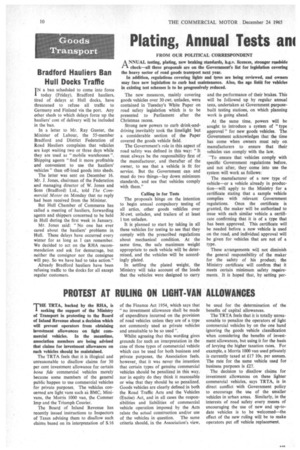Plating, Annual Tests am
Page 12

If you've noticed an error in this article please click here to report it so we can fix it.
FROM OUR POLITICAL CORRESPONDENT
A NNUAL testing, plating, new braking standards, h.g.v. licences, stronger roadside check—all these proposals are on the Government's list for legislation covering the heavy sector of road goods transport next year.
In addition, regulations covering lights and tyres are being reviewed, and owners may face new legislation to curb bad maintenance. Also, the age lin% for vehicles in existing test schemes is to be progressively reduced.
The new measures, mainly covering goods vehicles over 30 cwt. unladen, were contained in Tuesday's White Paper on road safety legislation which is to be presented to Parliament after the Christmas recess.
Strong new powers to curb drink-anddriving inevitably took the limelight but a considerable section of the Paper covered the goods vehicle field.
The Government's role in this aspect of road safety was defined in this way: "It must always be the responsibility first of the mantifacturer, and therafter of the owner, to see that a vehicle is fit for service. But the Government can and must do two things—lay down minimum standards, and see that vehicles comply with them."
Calling in for Tests The proposals hinge on the intention to begin annual compulsory testing of all artics, other goods vehicles over 30 cwt, unladen, and trailers of at least 1 ton unladen.
It is planned to start by taking in all these vehicles for testing to see that they comply with the prescribed regulations about mechanical condition. At the same time, the safe maximum weight appropriate to each vehicle will be determined, and the vehicles will be accordingly plated.
In settling the plated weight, the Ministry will take account of the loads that the vehicles were designed to carry and the performance of their brakes. This will be followed up by regular annual tests, undertaken at Government purposebuilt testing stations, on which planning work is going ahead.
At the same time, powers will be sought to introduce a system of "type approval" for new goods vehicles. The Government acknowledges that the time has come when owners must rely on manufacturers to ensure that their vehicles can comply with the law.
To ensure that vehicles comply with specific Government regulations before, and not after, they come into use the system will work as follows: The manufacturer of a new type of vehicle—or a vehicle already in production—will apply to the Ministry for a certificate stating that a sample vehicle complies with relevant Government regulations. Once the certificate is granted, the maker will be authorized to issue with each similar vehicle a certificate confirming that it is of a type that has been approved. This certificate will be needed before a new vehicle is used on the road, and individual approval will be given for vehicles that are not of a type.
These arrangements will not diminish the general responsibility of the maker for the safety of his product; the Ministry certificate will confirm that it meets certain minimum safety requirements. It is hoped that, by setting per












































































